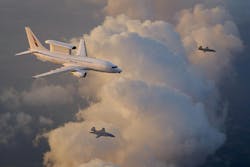Boeing, RAAF demonstrate airborne control of multiple MQ-28 drones
Summary points:
-
Multi-Drone Control from E-7A: Boeing and the Royal Australian Air Force successfully controlled two MQ-28 Ghost Bat drones and a simulated third aircraft from a single operator aboard an E-7A Wedgetail in a first-of-its-kind demonstration.
-
Software Collaboration: The test validated Boeing’s open systems architecture and software developed in partnership with Boeing Defence Australia, Australia’s DSTG, and the U.S. Air Force Research Laboratory.
-
Part of Broader CD25 Campaign: This demonstration is part of Capability Demonstration 2025, which will test the integration of MQ-28 aircraft with other RAAF assets, including F/A-18F Super Hornets and F-35s.
WOOMERA, South Australia - The Boeing Company in Arlington County, Va., and the Royal Australian Air Force (RAAF) successfully demonstrated the control of multiple MQ-28 Ghost Bat uncrewed aircraft from an airborne E-7A Wedgetail, marking a significant milestone in autonomous air combat development.
In a first-of-its-kind test, two in-flight MQ-28s and a third simulated aircraft were operated by a single crew member aboard the E-7A. The mission highlighted how uncrewed systems can support and protect crewed aircraft by flying ahead and relaying critical data.
"This trial demonstrates family-of-systems integration, the strength of our open systems architecture, and is a critical first step towards integrating mission partners' software and communications systems natively into the E-7A Wedgetail," said Glen Ferguson, director of MQ-28 Global Programs at Boeing.
Ferguson added that the test not only validated the MQ-28’s concept of operations but also showed how collaborative combat aircraft could extend the capabilities of the E-7A in future operations. "It is another tangible proof point of the maturity of our program," he said.
Australian Minister for Defence Industry Pat Conroy called the Ghost Bat program transformative, noting, "The Ghost Bat has the potential to turn a single fighter jet into a fighting team, with advanced sensors that are like hundreds of eyes in the sky."
Boeing Defence Australia, the Defence Science and Technology Group, and the U.S. Air Force Research Laboratory jointly developed the software enabling the demonstration.
"This has been an exceptional collaborative effort across organizations from government, contractors, and global partners," said Adam Tsacoumangos, director of Air Dominance Programs at Boeing’s Phantom Works.
The test was part of Capability Demonstration 2025 (CD25), a series of planned exercises designed to show how the MQ-28 can operate alongside RAAF crewed platforms. Future CD25 events will include integration with F/A-18F Super Hornets and F-35 Lightning II aircraft.
About the Author
Jamie Whitney
Senior Editor
Jamie Whitney joined the staff of Military & Aerospace Electronics in 2018 and oversees editorial content and produces news and features for Military & Aerospace Electronics, attends industry events, produces Webcasts, and oversees print production of Military & Aerospace Electronics.
